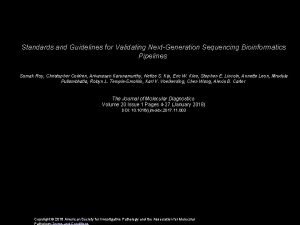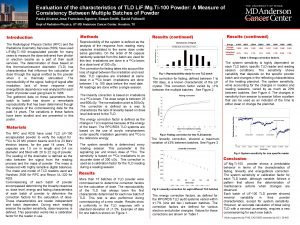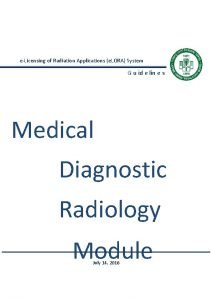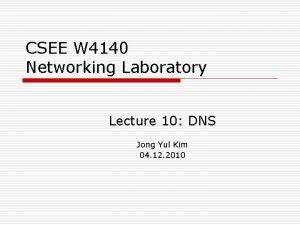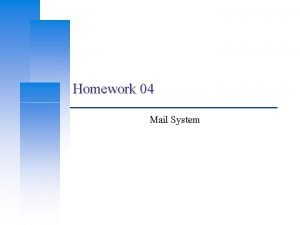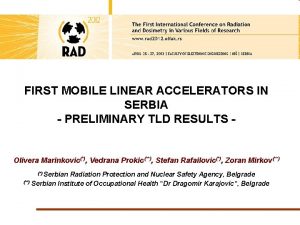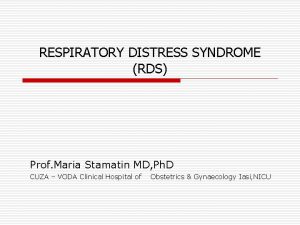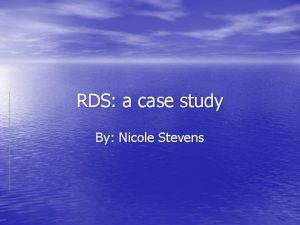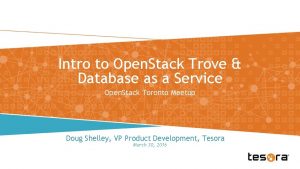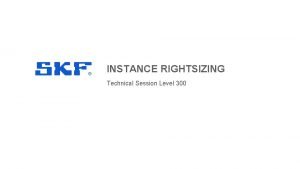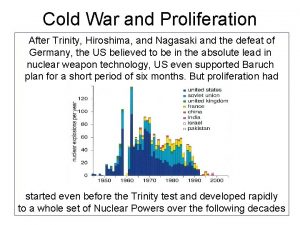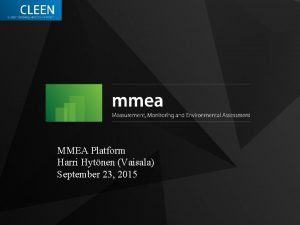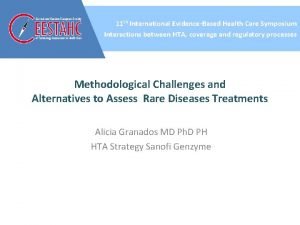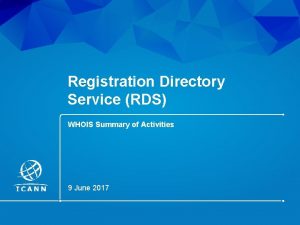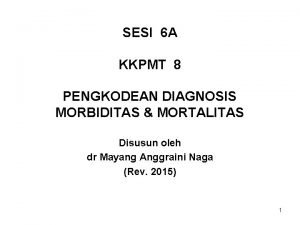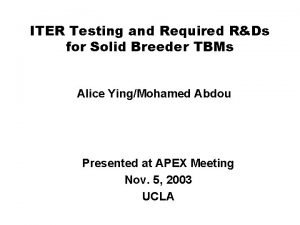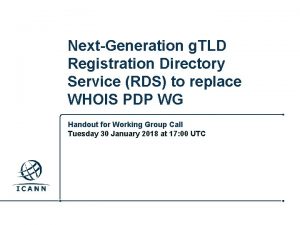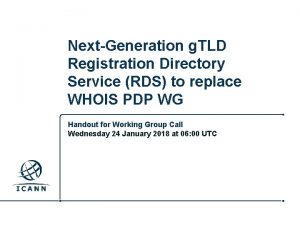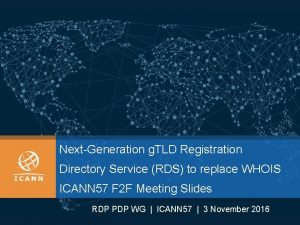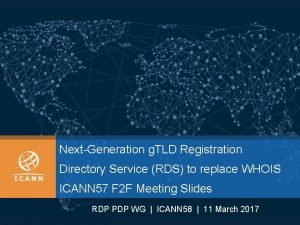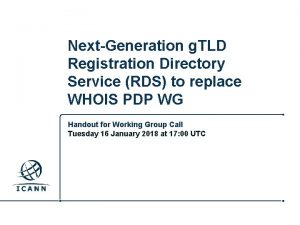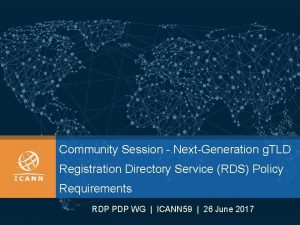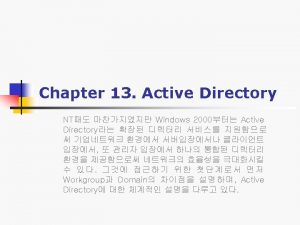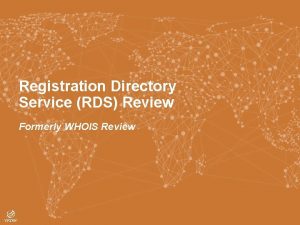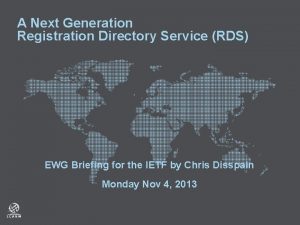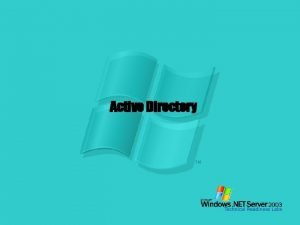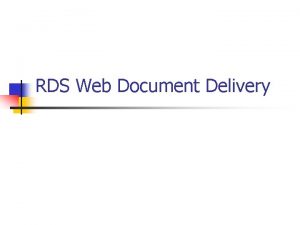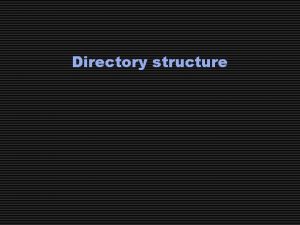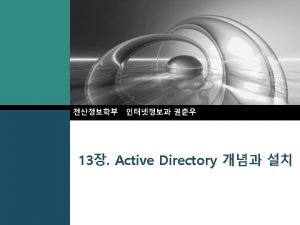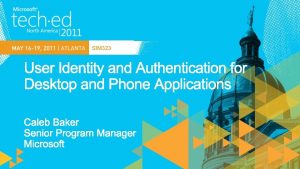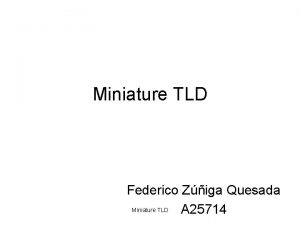NextGeneration g TLD Registration Directory Service RDS to























- Slides: 23

Next-Generation g. TLD Registration Directory Service (RDS) to replace WHOIS PDP WG Handout for Working Group Call Wednesday 20 December 2017 at 06: 00 UTC

Proposed Agenda 1. Roll Call/SOI Updates 2. Complete deliberation on Domain Name Management as a legitimate purpose Review poll results for data needed for Domain Name Management b) Finalize Data Elements needed for Domain Name Management Note: Deliberate later on data access and users for that purpose a) 3. Start deliberation on Domain Name Certification as a legitimate purpose 4. Confirm action items and proposed decision points 5. Confirm next WG meeting: Tuesday, 9 January at 17: 00 UTC Note: NO meetings for next two weeks - Happy Holidays to all Meeting Materials: https: //community. icann. org/x/NQBy. B |

2 a) Review Poll Results Level of support for each data element possibly required for the purpose of Domain Name Management: 100 -90%: Domain Name, Registrant Organization, Registrant Email, Registrar Name, Creation Date 89 -80%: Updated Date, Expiration Date, Nameservers, Domain Status 79 -70%: Registrant Postal Address, Registrant Phone, Administrative Contact Less than 60%: Registrar Abuse Contact, Original Registration Date, Technical Contact See https: //community. icann. org/download/attachments/ 74580021/Annotated. Results-Poll-from-12 December. pdf |

Annotated Poll Results |4

Comments provided in Poll Results |5

2 b) Finalize Data required for DN Management Possible WG Agreement The following registration data is needed for the purpose of Domain Name Management: Domain Name Registrant Organization Registrant Email Registrar Name Creation Date Updated Date Expiration Date Nameservers Domain Status Administrative Contact The above text includes all data elements with 100 -82% support in last week’s poll, plus Administrative Contact (pending discussion of comments on that item). Note: We will deliberate later on data access and users for Domain Name Management |6

3) Start deliberation on Domain Name Certification Reminder: Our plan for answering “Purpose” charter question Take building-block approach, deliberating on each purpose one-by-one 1. First, agree whether this specific purpose should be considered legitimate for collecting some registration data and why 2. Next, identify data elements required to support this specific purpose a) Which data may already be collected for another purpose? b) Which data may need to be collected for this purpose? 3. Add any data elements identified to the set of registration data elements potentially made accessible through the RDS • For now, defer discussion of collection conditions or access controls which might be applied to each data element Note that any agreement on legitimacy of one purpose does not preclude additional purposes being agreed as legitimate for the same or other data |

Domain Name Certification – Intro by DT 3 Purpose Name: Domain Name Certification Purpose: Information collected by a certificate authority to enable contact between the registrant, or a technical or administrative representative of the registrant, to assist in verifying that the identity of the certificate applicant is the same as the entity that controls the domain name. Definition: The role of a certificate authority (CA) is to bind an identity to a cryptographic key in the form of a cryptographic certificate. In the case of TLS certificate issuance the CA also needs the ability the validate and verify that the identify of the certificate applicant is the same as the entity that owns the domain name (e. g. the Registrant). While the process and rigor of CA validation and verification procedures vary, both by the nature of the certificate desired and the processes of individual CAs, the WHOIS system can be used to validate the certificate applicants ownership of control of the corresponding domain. |

Domain Name Certification – Intro by DT 3 Tasks: A Certificate Authority may issue certificates with different validation levels. The three levels of validation in standard use are Domain-validated, Organisation Validation, and Extended Validation. Domain-validated certificates require only demonstration of administrative control over the domain, and so do not require interaction with the RDS, and may be validated only using the DNS (optionally including other mechanisms such as email). They are therefore of limited relevance to this purpose. Organisation Validated certificates require identification of the organization that requests the certificate, validation methods and levels vary. We have noted Extended Validation certificates as the most explicitly relevant to the purpose, but Organisation Validated certificates are also relevant. Guidelines for the Issuance and Validation of Extended Validation certificates may be found at https: //cabforum. org/wp-content/uploads/EV-V 1_6_5. pdf Extended Validation certificates explicitly identify the legal entity that controls a web site as their primary purpose. They apply only to organisations, but for Business Entities (as defined in the EV guidelines 8. 5. 4) the validation process requires confirming the identity and authority of individuals applying for certificates. At a high level Certificate Authorities may perform the following tasks. • • • Confirm that the enrolling organization (requesting the certificate) is listed as the Registrant in the WHOIS Send one of the WHOIS contacts (registrant/admin/technical) an email to confirm domain authorization/control Call one of the WHOIS contacts (registrant/admin/technical) to confirm domain authorization/control Details of how this happens are defined in the CA Browser Forum’s (CABForum) Practices Section 3. 2. 2. 4 (https: //cabforum. org/wp-content/uploads/CA-Browser-Forum-BR-1. 5. 2. pdf) |

Domain Name Certification – Intro by DT 3 Section 3. 2. 2. 4 of the Baseline requirements is explicitly required for Extended Validation certificates by rules 11. 7. 1 of the Extended Validation Guidelines. 3. 2. 2. 4. Validation of Domain Authorization or Control 3. 2. 2. 4. 1 Validating the Applicant as a Domain Contact 3. 2. 2. 4. 2 Email, Fax, SMS, or Postal Mail to Domain Contact 3. 2. 2. 4. 3 Phone Contact with Domain Contact 3. 2. 2. 4. 4 Constructed Email to Domain Contact See DT 3: Domain Name Certification PDF for excerpts of the above sections Note: DT 3 did not find that access to all RDS data was required in all cases, but was required for some CA validation methods. Users: Describe the parties who often access g. TLD registration data in pursuit of this purpose. Employees of Certificate Authorities and automated systems associated with Certificate Authorities responsible for preforming the validation and verification as described above. |

Domain Name Certification – Intro by DT 3 Data: List of g. TLD registration data often involved in this purpose – for contact data, please identify the data subject (e. g. , registrant, tech contact, registrar, etc. ) and data element(s) as applicable. Data Element Domain Name Registrant, Tech and Admin Email Purpose To match with FQDN placed into the certificate. A means to contact the owner of the domain name, using manual or automated processes, with the goal of confirming that the identity of the certificate applicant is the same as entity that owns the domain name. Registrant, Tech and Admin Phone Used as an alternative method of contact in circumstances where Email is not available or when an additional level of manual or automated verification is needed. Used when necessary to confirm an individual can or does work for or represent the applying organization. Used to confirm that the organization of the entity that owns the domain name matches the organization of the certificate applicant. Also used in authentication/verification scenarios that are postal mail based. Registrant, Tech and Admin Name Registrant, Tech and Admin Postal Address (Street, City, State/Province, Country) Are there any clarifications necessary to understand this purpose before we can begin deliberating on this purpose? |

Is Domain Name Certification a legitimate purpose? Recall criteria: What makes a purpose legitimate? For example: Test Domain Name Certification (as drafted by DT 3) against criteria Does it support ICANN's mission? Is it specific? Is it explained in a way that registrants can understand? Does it explain to registrants what their data will be used for? Is it necessary for the fulfilment of a contract? Other? Information collected by a certificate authority to enable contact between the registrant, or a technical or administrative representative of the registrant, to assist in verifying that the identity of the certificate applicant is the same as the entity that controls the domain name. Reach agreement(s) on legitimacy of Domain Name Certification as a purpose for collecting some registration data Possible WG Agreement: Domain Name Certification is NOT a legitimate purpose for collecting registration data, but may be a legitimate purpose for using some data collected for other purposes. (Access requirements to be deliberated at a later stage. ) |

Confirm action items and decision points 20 December WG Call Meeting Materials: https: //community. icann. org/x/NQBy. B Next call: Tuesday, 9 January, 2018 at 17: 00 UTC |

DT definitions for each possible purpose Name Single-Sentence Definition Technical Issue Resolution Information collected to enable contact of the relevant contacts to facilitate tracing, identification and resolution of incidents related to services associated with the domain name by persons who are affected by such issues, or persons tasked (directly or indirectly) with the resolution of such issues on their behalf. Academic or Public Interest Research Information collected to enable use of registration data elements by researchers and other similar persons, as a source for academic or other public interest studies or research, relating either solely or in part to the use of the DNS. Domain Name Management Information collected to create a new domain name registration and ensuring that the domain registration records are under the control of the authorized party and that no unauthorized changes, transfers are made in the record. Individual Internet Use Collecting the required information of the registrant or relevant contact in the record to allow the internet user to contact or determine reputation of the domain name registration. |

DT definitions for each possible purpose Name Single-Sentence Definition Domain Name Certification Information collected by a certificate authority to enable contact between the registrant, or a technical or administrative representative of the registrant, to assist in verifying that the identity of the certificate applicant is the same as the entity that controls the domain name. Domain Name Purchase/Sale Information to enable contact between the registrant and third-party buyer to assist registrant in proving and exercising property interest in the domain name and thirdparty buyer in confirming the registrant's property interest and related merchantability. ICANN Contractual Enforcement Information accessed to enable ICANN Compliance to monitor and enforce contracted parties’ agreements with ICANN. Regulatory Enforcement Information accessed by regulatory entities to enable contact with the registrant to ensure compliance with applicable laws. |

DT definitions for each possible purpose Name Single-Sentence Definition Legal Actions Includes assisting certain parties (or their legal representatives, agents or service providers) to investigate and enforce civil and criminal laws, protect recognized legal rights, address online abuse or contractual compliance matters, or to assist parties defending against these kinds of activities, in each case with respect to all stages associated with such activities, including investigative stages; communications with registrants, registration authorities or hosting providers, or administrative or technical personnel relevant to the domain at issue; arbitrations; administrative proceedings; civil litigations (private or public); and criminal prosecutions. Criminal Activity/ DNS Abuse – Investigation Information to be made available to regulatory authorities, law enforcement, cybersecurity professionals, IT administrators, automated protection systems and other incident responders for the purpose of enabling identification of the nature of the registration and operation of a domain name linked to abuse and/or criminal activities to facilitate the eventual mitigation and resolution of the abuse identified: Domain metadata (registrar, registration date, nameservers, etc. ), Registrant contact information, Registrar contact Information, DNS contact, etc. . |

DT definitions for each possible purpose Name Single-Sentence Definition Criminal Activity/ DNS Abuse – Notification Information collected and made available for the purpose of enabling notification by regulatory authorities, law enforcement, cybersecurity professionals, IT administrators, automated protection systems and other incident responders of the appropriate party (registrant, providers of associated services, registrar, etc), of abuse linked to a certain domain name registration to facilitate the mitigation and resolution of the abuse identified: Registrant contact information, Registrar contact Information, DNS contact, etc. . Criminal Activity/ DNS Abuse – Reputation Information made available to organizations running automated protection systems for the purpose of enabling the establishment of reputation for a domain name to facilitate the provision of services and acceptance of communications from the domain name examined: Domain metadata (registrar, registration date, nameservers, etc. ), Registrant contact information, Registrar contact Information, DNS contact, etc. . |

ICANN’s Mission (As amended 1 October 2016) Section 1. 1. MISSION (a) The mission of the Internet Corporation for Assigned Names and Numbers ("ICANN") is to ensure the stable and secure operation of the Internet's unique identifier systems as described in this Section 1. 1(a) (the "Mission"). Specifically, ICANN: (i) Coordinates the allocation and assignment of names in the root zone of the Domain Name System ("DNS") and coordinates the development and implementation of policies concerning the registration of second-level domain names in generic top-level domains ("g. TLDs"). In this role, ICANN's scope is to coordinate the development and implementation of policies: • For which uniform or coordinated resolution is reasonably necessary to facilitate the openness, interoperability, resilience, security and/or stability of the DNS including, with respect to g. TLD registrars and registries, policies in the areas described in Annex G-1 and Annex G-2; and • That are developed through a bottom-up consensus-based multistakeholder process and designed to ensure the stable and secure operation of the Internet's unique names systems. • The issues, policies, procedures, and principles addressed in Annex G-1 and Annex G-2 with respect to g. TLD registrars and registries shall be deemed to be within ICANN's Mission. (…. . . ) See https: //www. icann. org/resources/pages/governance/bylaws-en/#article 1 for further details | 18

Annex G-1 of the ICANN Bylaws (As amended 1 October 2016) ANNEX G-1 The topics, issues, policies, procedures and principles referenced in Section 1. 1(a)(i) with respect to g. TLD registrars are: • issues for which uniform or coordinated resolution is reasonably necessary to facilitate interoperability, security and/or stability of the Internet, registrar services, registry services, or the DNS; • functional and performance specifications for the provision of registrar services; • registrar policies reasonably necessary to implement Consensus Policies relating to a g. TLD registry; • resolution of disputes regarding the registration of domain names (as opposed to the use of such domain names, but including where such policies take into account use of the domain names); or • restrictions on cross-ownership of registry operators and registrars or resellers and regulations and restrictions with respect to registrar and registry operations and the use of registry and registrar data in the event that a registry operator and a registrar or reseller are affiliated. Examples of the above include, without limitation: • principles for allocation of registered names in a TLD (e. g. , first-come/first-served, timely renewal, holding period after expiration); • prohibitions on warehousing of or speculation in domain names by registries or registrars; • reservation of registered names in a TLD that may not be registered initially or that may not be renewed due to reasons reasonably related to (i) avoidance of confusion among or misleading of users, (ii) intellectual property, or (iii) the technical management of the DNS or the Internet (e. g. , establishment of reservations of names from registration); • maintenance of and access to accurate and up-to-date information concerning registered names and name servers; • procedures to avoid disruptions of domain name registrations due to suspension or termination of operations by a registry operator or a registrar, including procedures for allocation of responsibility among continuing registrars of the registered names sponsored in a TLD by a registrar losing accreditation; and • the transfer of registration data upon a change in registrar sponsoring one or more registered names. | 19

Annex G-2 of the ICANN Bylaws (As amended 1 October 2016) ANNEX G-2 The topics, issues, policies, procedures and principles referenced in Section 1. 1(a)(i) with respect to g. TLD registries are: • issues for which uniform or coordinated resolution is reasonably necessary to facilitate interoperability, security and/or stability of the Internet or DNS; • functional and performance specifications for the provision of registry services; • security and stability of the registry database for a TLD; • registry policies reasonably necessary to implement Consensus Policies relating to registry operations or registrars; • resolution of disputes regarding the registration of domain names (as opposed to the use of such domain names); or • restrictions on cross-ownership of registry operators and registrars or registrar resellers and regulations and restrictions with respect to registry operations and the use of registry and registrar data in the event that a registry operator and a registrar or registrar reseller are affiliated. Examples of the above include, without limitation: • principles for allocation of registered names in a TLD (e. g. , first-come/first-served, timely renewal, holding period after expiration); • prohibitions on warehousing of or speculation in domain names by registries or registrars; • reservation of registered names in the TLD that may not be registered initially or that may not be renewed due to reasons reasonably related to (i) avoidance of confusion among or misleading of users, (ii) intellectual property, or (iii) the technical management of the DNS or the Internet (e. g. , establishment of reservations of names from registration); • maintenance of and access to accurate and up-to-date information concerning domain name registrations; and • procedures to avoid disruptions of domain name registrations due to suspension or termination of operations by a registry operator or a registrar, including procedures for allocation of responsibility for serving registered domain names in a TLD affected by such a suspension or termination. | 20

Example WHOIS Record From Registry Agreement Domain Name: EXAMPLE. TLD Domain ID: D 1234567 -TLD WHOIS Server: whois. example. tld Referral URL: http: //www. example. tld Updated Date: 2009 -05 -29 T 20: 13: 00 Z Creation Date: 2000 -10 -08 T 00: 45: 00 Z Registry Expiry Date: 2010 -10 -08 T 00: 44: 59 Z Sponsoring Registrar: EXAMPLE REGISTRAR LLC Sponsoring Registrar IANA ID: 5555555 Domain Status: client. Delete. Prohibited Domain Status: client. Renew. Prohibited Domain Status: client. Transfer. Prohibited Domain Status: server. Update. Prohibited Registrant ID: 5372808 -ERL Registrant Name: EXAMPLE REGISTRANT Registrant Organization: EXAMPLE ORGANIZATION Registrant Street: 123 EXAMPLE STREET Registrant City: ANYTOWN Registrant State/Province: AP Registrant Postal Code: A 1 A 1 A 1 Registrant Country: EX Registrant Phone: +1. 5555551212 Registrant Phone Ext: 1234 Registrant Fax: +1. 5555551213 Registrant Fax Ext: 4321 Registrant Email: EMAIL@EXAMPLE. TL D Admin ID: 5372809 -ERL Admin Name: EXAMPLE REGISTRANT ADMINISTRATIVE Admin Organization: EXAMPLE REGISTRANT ORGANIZATION Admin Street: 123 EXAMPLE STREET Admin City: ANYTOWN Admin State/Province: AP Admin Postal Code: A 1 A 1 A 1 Admin Country: EX Admin Phone: +1. 5555551212 Admin Phone Ext: 1234 Admin Fax: +1. 5555551213 Admin Fax Ext: Admin Email: EMAIL@EXAMPLE. TLD Tech ID: 5372811 -ERL Tech Name: EXAMPLE REGISTRAR TECHNICAL Tech Organization: EXAMPLE REGISTRAR LLC Tech Street: 123 EXAMPLE STREET Tech City: ANYTOWN Tech State/Province: AP Tech Postal Code: A 1 A 1 A 1 Tech Country: EX Tech Phone: +1. 1235551234 Tech Phone Ext: 1234 Tech Fax: +1. 5555551213 Tech Fax Ext: 93 Tech Email: EMAIL@EXAMPLE. TLD Name Server: NS 01. EXAMPLEREGISTRAR. TLD Name Server: NS 02. EXAMPLEREGISTRAR. TLD DNSSEC: signed. Delegation DNSSEC: unsigned >>> Last update of WHOIS database: 2009 -05 -29 T 20: 15: 00 Z <<< https: //newgtlds. icann. org/sites/default/files/agreement-approved-31 jul 17 -en. pdf | 21

Data needs identified by DT 2… |

Data needs identified by DT 2 (continued) |
 Guidelines for validation nextgeneration
Guidelines for validation nextgeneration Tld li
Tld li Ultratech tld form
Ultratech tld form Tld 4140
Tld 4140 Ntcu tld
Ntcu tld Bncde
Bncde Silverman score
Silverman score Pathophysiology of pneumonia
Pathophysiology of pneumonia Rds case study
Rds case study Openstack rds
Openstack rds Holger feix
Holger feix Rds mcas
Rds mcas Rds 37 bomb
Rds 37 bomb Downe score
Downe score Rds vaisala
Rds vaisala Anneli kari
Anneli kari Webrds
Webrds Naviance cphs
Naviance cphs Innoval rds
Innoval rds I cann whois
I cann whois Rds.csa
Rds.csa Tssdis service
Tssdis service Kode icd 10 letak lintang
Kode icd 10 letak lintang Rds cont
Rds cont
